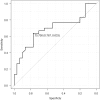The relationship between perioperative central venous oxygen saturation and postoperative complications in highly invasive gastroenterological surgery
- PMID: 38957557
- PMCID: PMC11216792
- DOI: 10.1002/ags3.12768
The relationship between perioperative central venous oxygen saturation and postoperative complications in highly invasive gastroenterological surgery
Abstract
Purpose: Operations for malignant diseases of the bile duct, pancreas, and esophagus are the most invasive gastroenterological surgeries. The frequency of complications after these surgeries is high, which affects the postoperative course and mortality. In patients who undergo these types of surgeries, continuous monitoring of the perioperative central venous oxygen saturation (ScvO2) is possible via a central venous catheter. We aimed to investigate the relationship between continuously monitored perioperative ScvO2 values and postoperative complications.
Methods: The medical records of 115 patients who underwent highly invasive gastroenterological surgeries and ScvO2 monitoring from April 2012 to March 2014 were analyzed. Sixty patients met the inclusion criteria, and their ScvO2 levels were continuously monitored perioperatively. The relationship between ScvO2 levels and major postoperative complications, defined as Clavien-Dindo grade ≥ III, was examined using uni- and multivariate analysis.
Results: Thirty patients developed major postoperative complications. The adequate cut-off value derived from receiver operating curves of the postoperative average ScvO2 levels for predicting major complications was 75%. Multivariate analysis revealed that low average postoperative ScvO2 levels (p = 0.016) and blood loss ≥ 1000 mL (p = 0.039) were significant predictors of major postoperative complications.
Conclusions: Low perioperative ScvO2 values were associated with an increased risk of major postoperative complications. Continuous ScvO2 monitoring will help prevent postoperative complications.
Keywords: anastomotic failure; central venous oxygen saturation; gastroenterological surgery; postoperative complications; surgical site infection.
© 2024 The Authors. Annals of Gastroenterological Surgery published by John Wiley & Sons Australia, Ltd on behalf of The Japanese Society of Gastroenterological Surgery.
Conflict of interest statement
The authors declare no conflicts of interest for this article.
Figures



Similar articles
-
Central venous O₂ saturation and venous-to-arterial CO₂ difference as complementary tools for goal-directed therapy during high-risk surgery.Crit Care. 2010;14(5):R193. doi: 10.1186/cc9310. Epub 2010 Oct 29. Crit Care. 2010. PMID: 21034476 Free PMC article. Clinical Trial.
-
Discrepancy between superior vena cava oxygen saturation and mixed venous oxygen saturation can predict postoperative complications in cardiac surgery patients.J Cardiothorac Vasc Anesth. 2014 Jun;28(3):528-33. doi: 10.1053/j.jvca.2013.03.002. Epub 2013 Aug 22. J Cardiothorac Vasc Anesth. 2014. PMID: 23972741
-
Multicentre study on peri- and postoperative central venous oxygen saturation in high-risk surgical patients.Crit Care. 2006;10(6):R158. doi: 10.1186/cc5094. Crit Care. 2006. PMID: 17101038 Free PMC article.
-
Continuous central venous oxygen saturation assisted intraoperative hemodynamic management during major abdominal surgery: a randomized, controlled trial.BMC Anesthesiol. 2015 Jun 4;15:82. doi: 10.1186/s12871-015-0064-2. BMC Anesthesiol. 2015. PMID: 26041437 Free PMC article. Clinical Trial.
-
Central venous oxygen saturation during high-risk general surgical procedures-relationship to complications and clinical outcomes.Anaesth Intensive Care. 2014 Jan;42(1):28-36. doi: 10.1177/0310057X1404200107. Anaesth Intensive Care. 2014. PMID: 24471661
References
-
- Weiser TG, Haynes AB, Molina G, Lipsitz SR, Esquivel MM, Uribe‐Leitz T, et al. Estimate of the global volume of surgery in 2012: an assessment supporting improved health outcomes. Lancet. 2015;385(Suppl 2):S11. - PubMed
-
- Behrman SW, Rush BT, Dilawari RA. A modern analysis of morbidity after pancreatic resection. Am Surg. 2004;70(8):675–682. discussion 82–83. - PubMed
-
- Hirano S, Kondo S, Tanaka E, Shichinohe T, Tsuchikawa T, Kato K, et al. Outcome of surgical treatment of hilar cholangiocarcinoma: a special reference to postoperative morbidity and mortality. J Hepatobil Pancreat Sci. 2010;17(4):455–462. - PubMed
-
- Sheridan WG, Lowndes RH, Young HL. Tissue oxygen tension as a predictor of colonic anastomotic healing. Dis Colon Rectum. 1987;30(11):867–871. - PubMed
LinkOut - more resources
Full Text Sources
Miscellaneous

